The Desert Northwest
Botanical Expedition to Southern Washington
October 2011
Page 5 - Mt. Hood Country
|
The plan for day three of my trip was to cross into Oregon for some quick exploring in the Mt. Hood area, then return straight home. Despite my intentions to wake up and get going at the crackiest crack of dawn again, the morning was cloudy and dark and somehow I slept in later than I wanted to. By the time I got everything packed up, drove away, got gas (something I try not to do in Oregon if I don't really have to) and entered The Dalles it was 8:00. Then I had to find the right kind of oil for my car which seemed to need it since the warning light came on. Finally I took care of all that, and drove on out of The Dalles and up into the hills to the southwest on some back roads. The road turned to gravel sooner than I would have liked, but at least the gravel was very well maintained. Quercus garryana again dominated the landscape in this area.
|

|
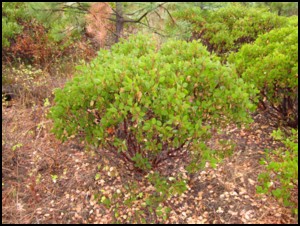
|
Shortly after 9:00 I spotted my first Arctostaphylos of the day, these A. patula. Compare this to the possible A. patula near Glenwood pictured earlier - standing 5' tall with well-spaced, dusky green leaves on upright branches, these looked quite different.
|
|
As I drove on I noticed some interesting variations in them including this one having rounded leaves with a little point at the end. This reminds me of the commonly seen leaf shape of A. patula in southern Utah, though the color is different.
|
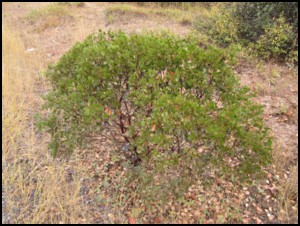
|
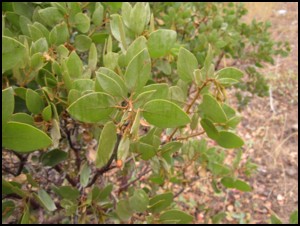
|
And this - well, can you imagine a more disgusting shade of green for a leaf? The camera doesn't do it justice, but in person it almost didn't look real.
|
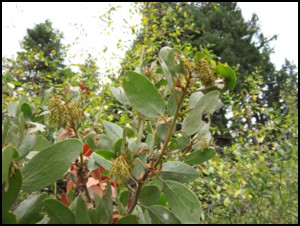
|
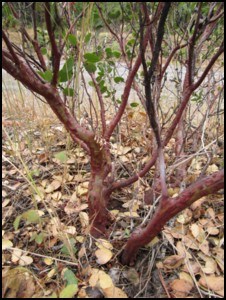
|
Occasionally I found a few A. patula that grew 8 - 9' tall like little trees, with great big leaves and flowers. Of course, they all have fabulous bark, but it really shows well on the taller plants.
|

|
Proceeding higher up I encountered what appeared to be a hybrids of A. patula and A. columbiana – at least, they looked intermediate between the two to my eye, and some plants had the characteristic hairs of A. columbiana. Curiously, I did not see any certain pure A. columbiana here, but perhaps a little more looking around would have turned a few of them up – though this is considerably higher up and farther east than I would expect to find it. Of course this hybrid is what I was hoping to find in Washington, but it may not exist.
|

|

|
Then at the same site I saw this plant that looked like one of the above hybrids having crossed with A. nevadensis, perhaps, which was also in the area.
|
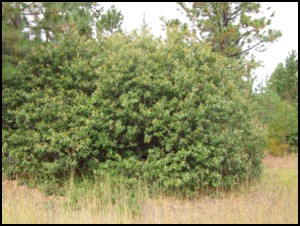
|
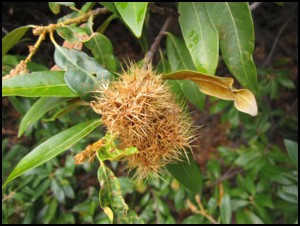
|
Finally Chrysolepis chrysophylla made an appearance. This evergreen oak relative inhabits remarkably high and cold places in the Oregon Cascades, yet it is almost impossible to find on the Washington side despite some records of it from Washington. It also has a reputation for being very difficult to establish and grow in gardens. The acorn-like seeds are buried deep within these spiny husks, and are difficult to extract.
|

|
Ceanothus prostratus is supposed to be common around this area, but I only saw it once. This form was quite a bit pricklier than the ones I saw in Washington.
|
|
Arctostaphylos patula x nevadensis hybrids were quite common in this area, including some very nice forms.
|

|

|
Near Mill Creek Buttes, I came across this A. patula with remarkably large leaves (and, I suppose, flowers, judging by the size of those flower buds). Chrysolepis chrysophylla also remained common in this area. Ceanothus prostratus was supposed to be here, but I didn't see any – though I didn't exactly spend a huge amount of time looking for it, as I needed to keep moving along.
|
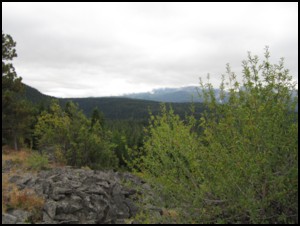
|

|
I climbed up a rocky knoll hoping to find more interesting Arctostaphylos, but in this case there was none whatsoever growing on the rocks. But I did find some especially robust colonies of Paxistima myrsinites (mountain boxwood) here.
|
|
Passing the Brooks Meadow area and heading down the hill towards Highway 35, I encountered a few more very nice Arctostaphylos patula x nevadensis hybrids, including one with large leaves on a plant that only grew about 8” tall, and one with little leaves growing into a huge, low shrub.
|
|
Finally joining up with Highway 35, I turned north, and entered an area where Arctostaphylos patula and A. columbiana grew together, producing occasional hybrid plants such as these. More Penstemons occurred here as well.
|

|
It was now approaching 1:00 and I was making my best effort to hurry along, but I had to bring my car to a screeching halt (well, nearly) for this awesome groundcover of mysterious origin. I didn't see any Arctostaphylos nevadensis around this area (as one would expect to produce the low habit and small-ish leaves) and the other parent does not seem to me obviously like either A. columbiana or A. patula - but I suppose the parents must somehow come from those species.
|
|
Near the Dog River trailhead were several more nice Arctostaphylos columbiana x A. patula forms.
|
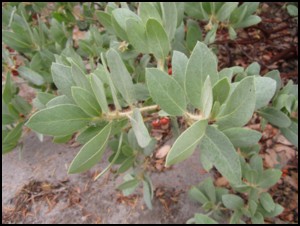
|
The last exciting thing I saw was this Arctostaphylos columbiana with larger leaves than I have ever seen on this species - wow! This was growing in very infertile pure sand. (Well, actually, I did see more exciting things as I headed west on I-84, such as a giant colony of A. x media, but I couldn't stop to check it out as I was going 68 miles per hour along the freeway with nowhere to get off.)
|
|
Finally, after stopping for lunch at some fancy pizza-by-the-slice place in downtown Hood River, I headed west on I-84 to I-5, and then home. My weekend time was running out and I knew I had better get going if I wanted to be back at a reasonable hour. I knew I would not have time to see everything there is to see near Mt. Hood, but I think I did really well for just one morning of botanical exploration in the area. It will be another place to return to in the future, especially since Mt. Hood did not show itself but remained hidden in clouds the entire morning.
So I think I really had a great trip. I covered a large area in a short amount of time and satisfied my curiosity as to what many of our native Arctostaphylos look like and where they can be found in the wild. I am also thrilled that my car survived the whole thing and still works fine even as I type this. Now at last my plant exploring bug has finally been quenched for the season. (Or at least for the next few weeks.)
|
The Desert Northwest: Travelogue Home |
Ian's Plants Page
|